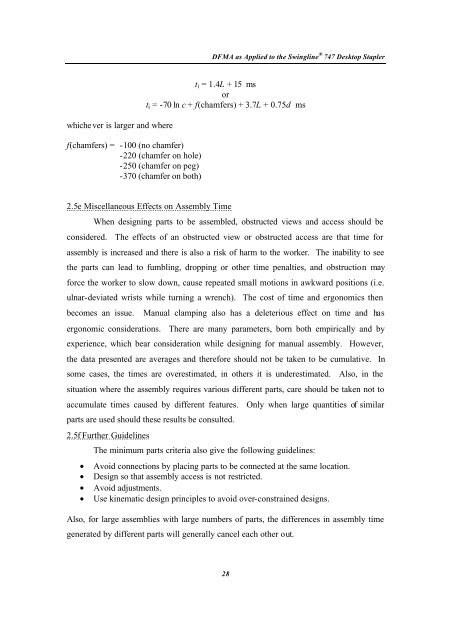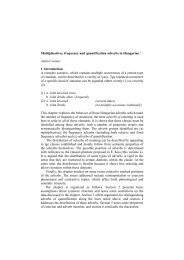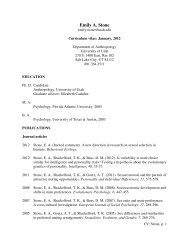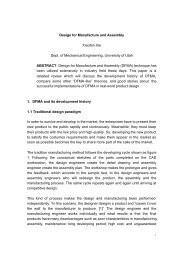DFMA as Applied to the Swingline 747 Desktop ... - University of Utah
DFMA as Applied to the Swingline 747 Desktop ... - University of Utah
DFMA as Applied to the Swingline 747 Desktop ... - University of Utah
You also want an ePaper? Increase the reach of your titles
YUMPU automatically turns print PDFs into web optimized ePapers that Google loves.
whichever is larger and where<br />
f(chamfers) = -100 (no chamfer)<br />
-220 (chamfer on hole)<br />
-250 (chamfer on peg)<br />
-370 (chamfer on both)<br />
<strong>DFMA</strong> <strong>as</strong> <strong>Applied</strong> <strong>to</strong> <strong>the</strong> <strong>Swingline</strong> ® <strong>747</strong> Desk<strong>to</strong>p Stapler<br />
ti = 1.4L + 15 ms<br />
or<br />
ti = -70 ln c + f(chamfers) + 3.7L + 0.75d ms<br />
2.5e Miscellaneous Effects on Assembly Time<br />
When designing parts <strong>to</strong> be <strong>as</strong>sembled, obstructed views and access should be<br />
considered. The effects <strong>of</strong> an obstructed view or obstructed access are that time for<br />
<strong>as</strong>sembly is incre<strong>as</strong>ed and <strong>the</strong>re is also a risk <strong>of</strong> harm <strong>to</strong> <strong>the</strong> worker. The inability <strong>to</strong> see<br />
<strong>the</strong> parts can lead <strong>to</strong> fumbling, dropping or o<strong>the</strong>r time penalties, and obstruction may<br />
force <strong>the</strong> worker <strong>to</strong> slow down, cause repeated small motions in awkward positions (i.e.<br />
ulnar-deviated wrists while turning a wrench). The cost <strong>of</strong> time and ergonomics <strong>the</strong>n<br />
becomes an issue. Manual clamping also h<strong>as</strong> a deleterious effect on time and h<strong>as</strong><br />
ergonomic considerations. There are many parameters, born both empirically and by<br />
experience, which bear consideration while designing for manual <strong>as</strong>sembly. However,<br />
<strong>the</strong> data presented are averages and <strong>the</strong>refore should not be taken <strong>to</strong> be cumulative. In<br />
some c<strong>as</strong>es, <strong>the</strong> times are overestimated, in o<strong>the</strong>rs it is underestimated. Also, in <strong>the</strong><br />
situation where <strong>the</strong> <strong>as</strong>sembly requires various different parts, care should be taken not <strong>to</strong><br />
accumulate times caused by different features. Only when large quantities <strong>of</strong> similar<br />
parts are used should <strong>the</strong>se results be consulted.<br />
2.5f Fur<strong>the</strong>r Guidelines<br />
The minimum parts criteria also give <strong>the</strong> following guidelines:<br />
• Avoid connections by placing parts <strong>to</strong> be connected at <strong>the</strong> same location.<br />
• Design so that <strong>as</strong>sembly access is not restricted.<br />
• Avoid adjustments.<br />
• Use kinematic design principles <strong>to</strong> avoid over-constrained designs.<br />
Also, for large <strong>as</strong>semblies with large numbers <strong>of</strong> parts, <strong>the</strong> differences in <strong>as</strong>sembly time<br />
generated by different parts will generally cancel each o<strong>the</strong>r out.<br />
28





